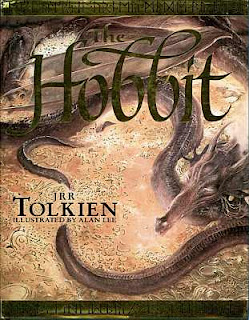The Hobbit, or There and Back Again, better known by its abbreviated title The Hobbit, is a fantasy novel and children's book by J. R. R. Tolkien. It was published on 21 September 1937 to wide critical acclaim, being nominated for the Carnegie Medal and awarded a prize from the New York Herald Tribune for best juvenile fiction. The book remains popular and is recognized as a classic in children's literature.
Set in a time "Between the Dawn of Færie and the Dominion of Men", The Hobbit follows the quest of home-loving hobbit Bilbo Baggins to win a share of the treasure guarded by the dragon, Smaug. Bilbo's journey takes him from light-hearted, rural surroundings into more sinister territory. The story is told in the form of an episodic quest, and most chapters introduce a specific creature, or type of creature, of Tolkien's Wilderland. By accepting the disreputable, romantic, fey and adventurous side of his nature and applying his wits and common sense, Bilbo gains a new level of maturity, competence and wisdom. The story reaches its climax in the Battle of Five Armies, where many of the characters and creatures from earlier chapters re-emerge to engage in conflict.
From the book
In a hole in the ground there lived a hobbit. Not a nasty, dirty, wet
hole, filled with the ends of worms and an oozy smell, nor yet a dry, bare,
sandy hole with nothing in it to sit down on or to eat: it was a hobbit-hole,
and that means comfort.
It had a perfectly round door like a porthole, painted green, with a
shiny yellow brass knob in the exact middle. The door opened on to a
tube-shaped hall like a tunnel: a very comfortable tunnel without smoke,
with panelled walls, and floors tiled and carpeted, provided with polished
chairs, and lots and lots of pegs for hats and coats - the hobbit was fond
of visitors. The tunnel wound on and on, going fairly but not quite straight
into the side of the hill - The Hill, as all the people for many miles round
called it - and many little round doors opened out of it, first on one side
and then on another. No going upstairs for the hobbit: bedrooms,
bathrooms, cellars, pantries (lots of these), wardrobes (he had whole
rooms devoted to clothes), kitchens, dining-rooms, all were on the same
floor, and indeed on the same passage. The best rooms were all on the
left-hand side (going in), for these were the only ones to have windows,
deep-set round windows looking over his garden and meadows beyond,
sloping down to the river.

No comments:
Post a Comment
leave your opinion